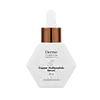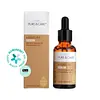What's inside
What's inside
 Key Ingredients
Key Ingredients

 Benefits
Benefits

 Concerns
Concerns

 Ingredients Side-by-side
Ingredients Side-by-side

Water
Skin ConditioningPropylene Glycol
HumectantGlyceryl Glucoside
HumectantCorn Gluten Amino Acids
Skin ConditioningHydrolyzed Beta-Glucan
Skin ConditioningSaccharide Isomerate
HumectantYeast Ferment Extract
Skin ConditioningAcetyl Hexapeptide-8
HumectantTripeptide-1
Skin ConditioningAcetyl Tetrapeptide-2
Skin ConditioningCopper Tripeptide-1
Skin ConditioningMentha Arvensis Leaf Extract
MaskingChrysanthellum Indicum Extract
Skin ConditioningPortulaca Oleracea Extract
Skin ConditioningAloe Barbadensis Extract
Skin ConditioningSophora Flavescens Root Extract
AntioxidantPanthenol
Skin ConditioningHydroxyacetophenone
AntioxidantHexylene Glycol
EmulsifyingSodium Hyaluronate
HumectantSodium Carbomer
Emulsion StabilisingWater, Propylene Glycol, Glyceryl Glucoside, Corn Gluten Amino Acids, Hydrolyzed Beta-Glucan, Saccharide Isomerate, Yeast Ferment Extract, Acetyl Hexapeptide-8, Tripeptide-1, Acetyl Tetrapeptide-2, Copper Tripeptide-1, Mentha Arvensis Leaf Extract, Chrysanthellum Indicum Extract, Portulaca Oleracea Extract, Aloe Barbadensis Extract, Sophora Flavescens Root Extract, Panthenol, Hydroxyacetophenone, Hexylene Glycol, Sodium Hyaluronate, Sodium Carbomer
Water
Skin ConditioningPropanediol
SolventGlycerin
HumectantCorn Gluten Amino Acids
Skin ConditioningGlyceryl Glucoside
HumectantSaccharide Isomerate
HumectantAcetyl Hexapeptide-8
HumectantSodium Hyaluronate
HumectantAloe Barbadensis Leaf Extract
EmollientYeast Ferment Extract
Skin ConditioningPanthenol
Skin ConditioningAvena Sativa Kernel Extract
AbrasiveMentha Arvensis Leaf Extract
MaskingPelargonium Graveolens Extract
MaskingSophora Flavescens Root Extract
AntioxidantChrysanthemum Indicum Flower Extract
Skin ConditioningPortulaca Oleracea Extract
Skin ConditioningCaprylyl Glycol
EmollientHexylene Glycol
EmulsifyingButylene Glycol
HumectantXanthan Gum
EmulsifyingCitric Acid
BufferingSodium Citrate
Buffering1,2-Hexanediol
Skin ConditioningPhenoxyethanol
PreservativePotassium Sorbate
PreservativeSodium Benzoate
MaskingSodium Hydroxide
BufferingEthylhexylglycerin
Skin ConditioningHydroxyacetophenone
AntioxidantWater, Propanediol, Glycerin, Corn Gluten Amino Acids, Glyceryl Glucoside, Saccharide Isomerate, Acetyl Hexapeptide-8, Sodium Hyaluronate, Aloe Barbadensis Leaf Extract, Yeast Ferment Extract, Panthenol, Avena Sativa Kernel Extract, Mentha Arvensis Leaf Extract, Pelargonium Graveolens Extract, Sophora Flavescens Root Extract, Chrysanthemum Indicum Flower Extract, Portulaca Oleracea Extract, Caprylyl Glycol, Hexylene Glycol, Butylene Glycol, Xanthan Gum, Citric Acid, Sodium Citrate, 1,2-Hexanediol, Phenoxyethanol, Potassium Sorbate, Sodium Benzoate, Sodium Hydroxide, Ethylhexylglycerin, Hydroxyacetophenone
Ingredients Explained
These ingredients are found in both products.
Ingredients higher up in an ingredient list are typically present in a larger amount.
Acetyl Hexapeptide-8, commonly known as Argireline or Acetyl Hexapeptide-3, is a popular peptide in skincare. It’s often referred to as a “Botox-like” ingredient because it helps reduce muscle movement.
By relaxing these micro-movements, Argireline may help minimize the appearance of fine lines and wrinkles. That said, it’s not as powerful as Botox, and research on its long-term effectiveness is still limited.
Beyond smoothing, Argireline may also support collagen production. Collagen is the protein that helps keep your skin firm, bouncy, and well-hydrated by strengthening the skin barrier.
So while Argireline isn’t a miracle fix, it can be a helpful addition to a routine focused on both prevention and skin health.
Read more about other common types of peptides here:
Learn more about Acetyl Hexapeptide-8We don't have a description for Corn Gluten Amino Acids yet.
Glyceryl Glucoside is made from glycerol and glucose.
It is a humectant. Humectants help hydrate your skin by drawing moisture to it from the air.
Some foods that contain glyceryl glucoside include sake, miso, and wines.
Learn more about Glyceryl GlucosideHexylene Glycol is a surfactant. Glycols are a class of alcohols. Hexylene Glycol is a surfactant and emulsifier.
As a surfactant, Hexylene Glycol helps gather dirt and oil on your skin to be washed away.
As an emulsifier, Hexylene Glycol helps keep water and oil together. This prevents them from separating in a product. Hexylene Glycol also thins out the texture of a product by lessening viscosity.
Hexylene Glycol has a small molecular weight.
Learn more about Hexylene GlycolHydroxyacetophenone is antioxidant with skin conditioning and soothing properties. It also boosts the efficiency of preservatives.
This ingredient is not irritating or sensitizing.
We don't have a description for Mentha Arvensis Leaf Extract yet.
Panthenol is a common ingredient that helps hydrate and soothe the skin. It is found naturally in our skin and hair.
There are two forms of panthenol: D and L.
D-panthenol is also known as dexpanthenol. Most cosmetics use dexpanthenol or a mixture of D and L-panthenol.
Panthenol is famous due to its ability to go deeper into the skin's layers. Using this ingredient has numerous pros (and no cons):
Like hyaluronic acid, panthenol is a humectant. Humectants are able to bind and hold large amounts of water to keep skin hydrated.
This ingredient works well for wound healing. It works by increasing tissue in the wound and helps close open wounds.
Once oxidized, panthenol converts to pantothenic acid. Panthothenic acid is found in all living cells.
This ingredient is also referred to as pro-vitamin B5.
Learn more about PanthenolThis extract comes from Purslane, a succulent. It has anti-inflammatory, antioxidant, and hydrating properties.
Purslane is very nutritious. It contains omega-3 fatty acids, NMFs, many vitamins, minerals, and antioxidants. The vitamins found in purslane include: Vitamin C, Vitamin A, and Vitamin E.
Fun fact: Purslane is a succulent with an extensive habitat. It is used in traditional Korean medicine to treat irritated skin.
Nowadays, purslane is becoming a superfood due to its highly nutritious content.
Learn more about Portulaca Oleracea ExtractSaccharide Isomerate comes from sugars found in corn. It is a skin hydrator.
The structure of this ingredient can be altered to be more similar to the carbohydrates found in our skin. This ability to mimic our skin gives it hydrating properties.
Specifically, saccharide Isomerate is a humectant. Humectants draw moisture from the air to our skin.
Research shows Saccharide Isomerate to be an effective moisturizer.
Learn more about Saccharide IsomerateSodium Hyaluronate is hyaluronic acid's salt form. It is commonly derived from the sodium salt of hyaluronic acid.
Like hyaluronic acid, it is great at holding water and acts as a humectant. This makes it a great skin hydrating ingredient.
Sodium Hyaluronate is naturally occurring in our bodies and is mostly found in eye fluid and joints.
These are some other common types of Hyaluronic Acid:
Learn more about Sodium HyaluronateSophora Flavescens Root Extract is an antioxidant.
Water. It's the most common cosmetic ingredient of all. You'll usually see it at the top of ingredient lists, meaning that it makes up the largest part of the product.
So why is it so popular? Water most often acts as a solvent - this means that it helps dissolve other ingredients into the formulation.
You'll also recognize water as that liquid we all need to stay alive. If you see this, drink a glass of water. Stay hydrated!
Learn more about WaterWe don't have a description for Yeast Ferment Extract yet.